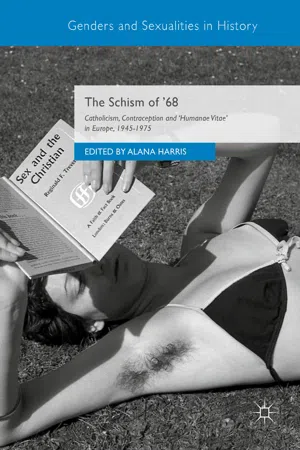In 1960, a year before the introduction of
Searle ’s contraceptive pill ‘
Conovid ’ to the British market,
1 the married layman, Taunton schoolmaster and co-founder of the annual ‘Catholic People’s Weeks’ (first held at Wadham College, Oxford in 1945) published
Sex and the Christian.
2 Produced within th e Burns and Oates ‘Faith and Fact’ series, this scholarly but highly accessible pamphlet advocated a Christian approach to sex
3 and the ‘formation of a solid doctrine of sexuality based on the facts of revelation and of science’.
4 As Trevett opined in the opening pages:
We have had enough of Sunday piety and the Christian-shut-up-in-the-castle mentality. We cannot go on forever trying to reconcile papal encyclicals on marriage with the Hollywood code by which most of our friends more or less live. … Mere pious exhortation, mere negative warnings are useless against this sort of barrage. We must look for weapons in a better armoury. Peter Maurin never tired of calling on Catholics, clerical and laity , to bring out what he would not surely call, were he alive, the ‘nuclear’ forces of the Church’s doctrine. Only truth can shatter falsehood, only the dynamic force of revelation can bring all that is genuine and good in the modern desire for a human and humane approach to love and sex into the great creative and redemptive synthesis which our Lord has achieved for our race. If this book can give a few pointers to this living spring of doctrine, it will have served its purpose. 5
In chapters surveying sources as diverse
as the Kinsey report and the work of Jung, coupled with sacramental theology and justified with the quip that ‘the patron of the Christian sexologist is not the
ostrich’, 6 Trevett was representative of a reforming strand of progressive theologians, confessors,
doctors , psychologists and educated
laity in Britain, but most particularly on the Continent, seeking to present ‘Catholic truth in the scientific age’. As Trevett surmised:
The sex problem is one of the most acute of our time; it offers the Christian a great opportunity. He must not think he has answered every question by quoting Canon Law. Law is no substitute for theology, still less for love . 7
This volume surveys the ways in which ordinary Catholic men and women, as well as the Vatican and the news media across Europe and the world, responded to the intensification of the ‘sex problem’ presented by the development of the anovulant pill in the late 1950s and its rejection as a licit form of birth regulation through Pope Paul VI’s infamous encyclical Humanae Vitae (HV) on 25 July 1968. That Reginald Trevett’s call for the prioritization of the experiences of the laity over male celibates continued to speak years later into this febrile debate—despite the author’s clear rejection of artificial barrier contraception and cautious sanction of the Knaus-Ogino or ‘rhythm method’ 8 —is hinted at by the photograph on the front cover of this edited collection. Taken in the Oxford University Parks in the Summer of 1968 by Paddy Summerfield, then a young man wrestling (as many within his generation) with the implications and actualities of the ‘sexual revolution ’ and the socioeconomic changes wrought by affluence, 9 the young woman sunbathing, reading and musing is evocative of the many enquiring Christians in the 1960s whose loyal dissent led to an irreparable rift in the church. It is their attempts to reconcile their faith with, as Trevett called it, ‘the “sexual climate” of our times’, 10 and their anguished engagement with and interrogation of the papal prohibition, which form the subject of this book.
This edited collection brings together historians of gender, sexuality and modern Catholicism to discuss the differing reactions to and reception of the HV encyclical by Catholic laity and clergy, episcopacies, medical professionals and media outlets across Europe. It situates the Vatican ’s highly controversial determination that the use of ‘artificial’ contraception by Catholics is ‘intrinsically wrong’ 11 within the longer trajectory of debates about ‘birth control ’ and the role of sex within companionate marriage emerging since the Second World War. In demonstrating how these debates, and the Catholic church’s important role within them, interacted with the social and sexual countercultures of the 1960s, it seeks to make an essential contribution to a growing historiography exploring ‘around ’68’. It also aims to contextualize and illuminate a lived history of the Second Vatican Council (1962–1965) and its afterlife, so often written from a predominantly theological perspective, by exploring the gendered, material and metaphysical grounds for heated opposition to and reinterpretation of the Vatican ruling. Common to these historiographical interventions is a focussed interrogation of the ‘secularization thesis’ as a descriptive and explanatory paradigm, 12 explored through the comparative perspective of fourteen European case studies. The composite picture of this geographically expansive and thematically broad enquiry illuminates the complex and divergent ways in which evolving mentalities about marriage , sexuality and reproduction, as well as conservative reactions (including HV itself and its interlocutors), had long histories, resonated with particular national circumstances, and were relayed through transnational networks of activists and intellectuals. The attempts by liberal, progressive Catholics to marry the insights of science, sociology and psychology with church teachings and sacramental theology culminated, ultimately, in an irreconcilable rent within the church, reinforced by the swing towards moral conservatism throughout Europe in the decade that followed. This was intensified through the ‘cultural wars’ which played out through the papacy of John Paul II and his ‘theology of the body ’ that Herzog discusses in the Afterword. On the cusp of the fiftieth anniversary of HV, these theological tensions remain unresolved, as the recent comments of Pope Francis demonstrate. 13 Yet for those Catholics who remained within the church after the furore, at least 78% of whom today support the use of contraceptives, 14 they have found their own solutions and ethical resolutions in living and loving after the encyclical.
